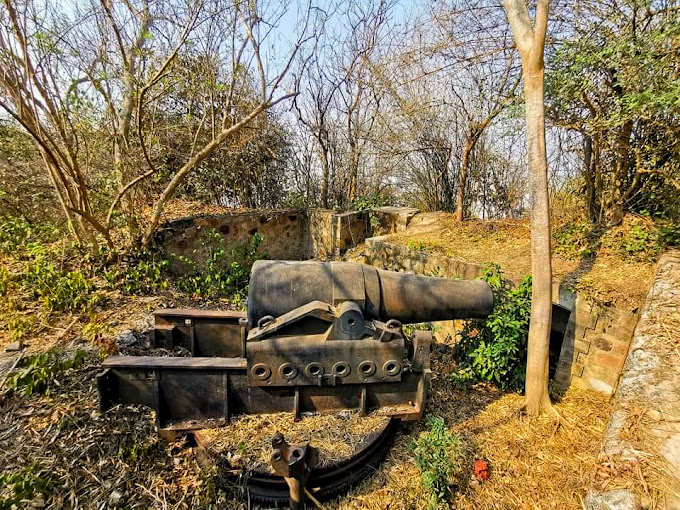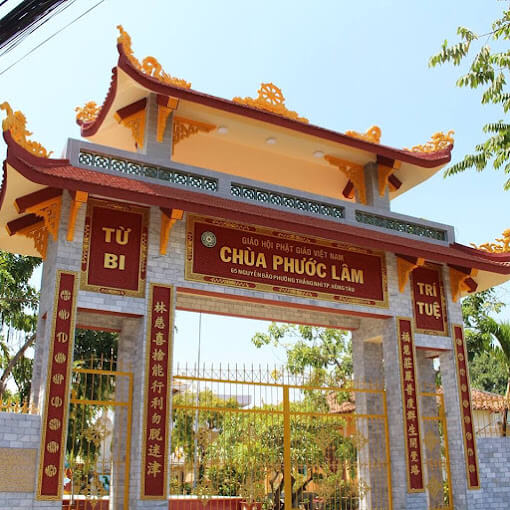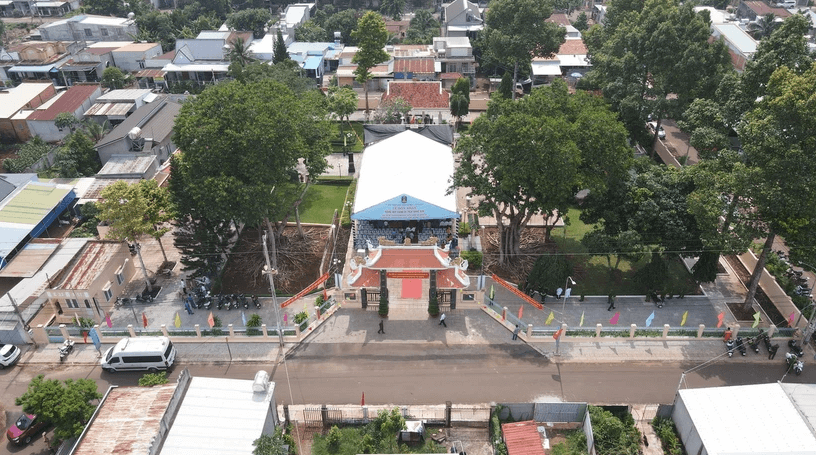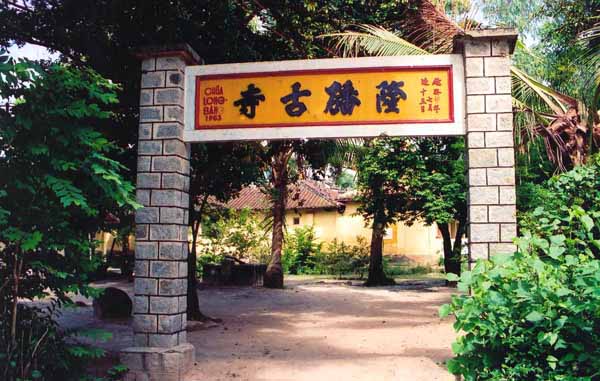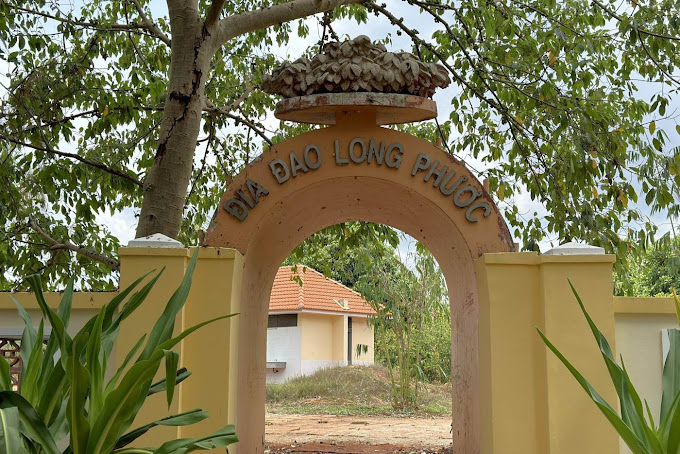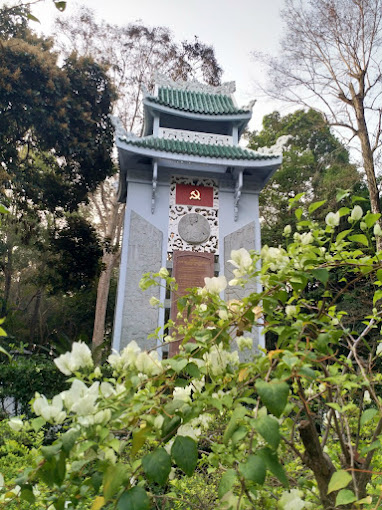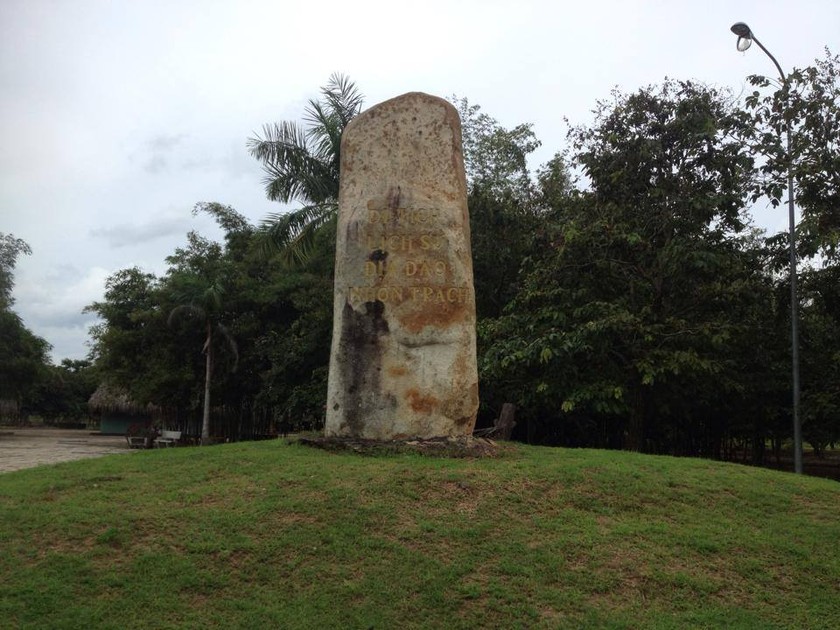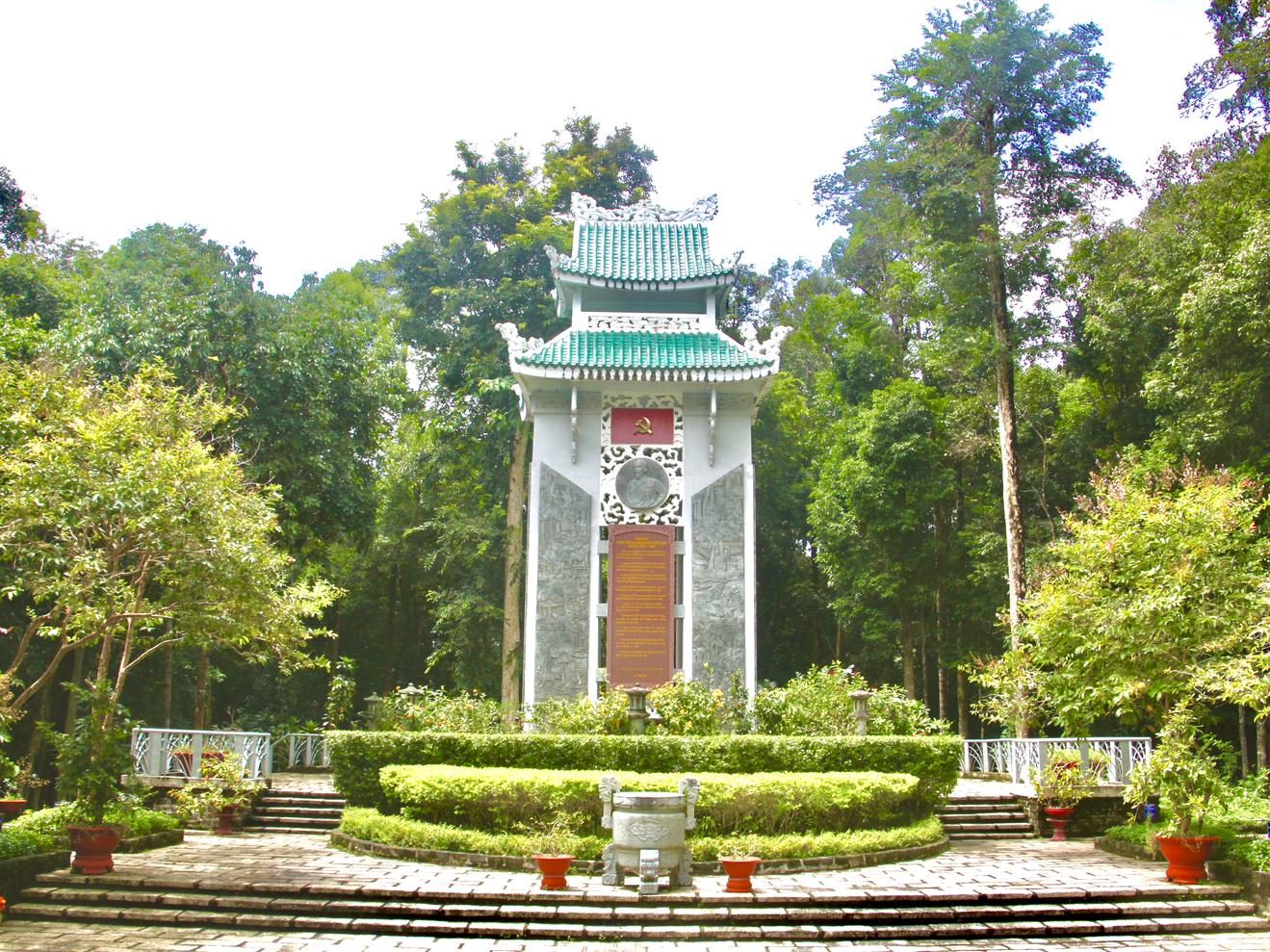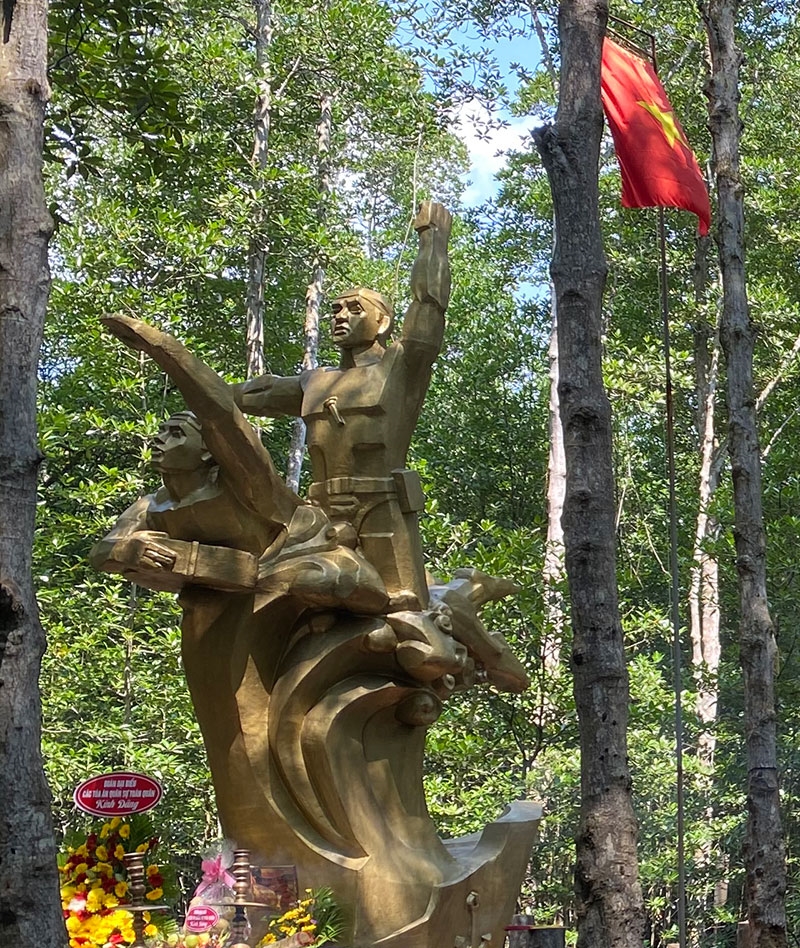Relic point Vietnam
Việt NamMonuments of the artillery battle on Tao Phung Mountain (Small Mountain)
This artillery battle also belongs to one of the three battles, forming the Vung Tau defense line of the French built at the same time as the Battle of the Great Mountain Artillery. The battle of small mountain artillery has the function of closing money and is arranged into three clusters in an arc cover both the East Sea and South Vung Tau. In order to build a artillery battle, it could be said that at that time the French colonialists arrested the people who were miserable to use the power of the rocks, breaking the mountains to make roads, digging trenches, building a fortune tunnel made by crafts, rudimentary vehicles have claimed so much life, sweat, blood and blood of our people. With that value, the ancient artillery battlefield on Tao Phung Mountain (Small Mountain) was issued by the Ministry of Culture and Information under Decision No. 57 Tánh/Decision, on January 18, 1993 of the Ministry of Culture and Information. Vung Tau artillery battle is the largest collection of ancient weapons in Indochina, this is a historical evidence of the extraordinary strength of our people. From the battlefield of the large mountain artillery, visitors follow the beach towards the front beach, to the right lighthouse before meeting the first section of the road or follow the entrance to the jade pure and at the foot of the statue + The first cluster is right at the foot of the statue of Christ, consisting of 3 gears at an average height of 136m above sea level and placed in a fortune dug deep under the ground. Has a diameter of 10.5m, these three firecrackers have the same design, structure, and the size of the bullet is 240mm, the barrel is 12.33mm long, the body of the artillery all records signs, the size of the gun barrel, the design and the five production, the weight of the artillery and the division of the team. + The second cluster (located in the lighthouse), including 5 guns, an average height of 91 m above sea level. These five firecrackers have the same design, structure and bullet size of 300mm. On the body of the artillery, all the necessary parameters. . This cluster is located about 300m north of the first artillery cluster. Currently, there are 04ks left, one of the guns left by guns was transferred to display in the collection of antique guns at Bach Dinh yard. +The second cluster (the jade pure), there are 3 people, at an average height of about 90m above sea level. The three firecrackers of this cluster are equal to 140mm. On the body of the artillery, all the necessary parameters. Currently, these 3 firecrackers are severely damaged, the necessary parameters. Currently, these 3 firecrackers are severely damaged, the parameters are abrasive. The three firecrackers are placed separately in three fortifications, equidistant 27m away and connected to each other by the trench and shelter system. Source of electronic portal in Ba Ria - Vung Tau province.
Ho Chi Minh City 1757 view
Phuoc Lam Pagoda
This is one of the ancient temples in Vung Tau city, dating back to nearly 200 years + The pagoda was rated the national monument in 1992 and was considered one of the local Buddhist centers, often with Buddhist monks and nuns in the country and internationally (mainly Indians) to enjoy and celebrate. On the big holidays such as the Lunar New Year, the full moon in January, the Buddha's Birthday, the Vu Lan ceremony ... the number of Buddhist monks and nuns to the temple is very large sometimes there is no place left. Therefore, the pagoda is planning to renovate, upgrade and expand the main hall but still preserve the old architectural features to help Buddhist monks and nuns are wholeheartedly towards the religion, and a destination to attract pilgrims and spiritual calendars. The pagoda has the four-pillar architecture of the ancient temple in the South with a rich Buddha image system: next to the lotus lake is the male statue of Nam Hai high, the main hall has the statues of DAD, Tam Ton, Shakyamuni, A Nam, Ca Lettuce, Buddha Entering Nirvana, Wooden Standard Statue, Ong Giam Bang Bang Bang ... Especially, the pagoda also preserves the statue of Vish Nu stone. The god of conservation is often in the South Central Cham towers. Source of electronic portal in Ba Ria - Vung Tau province.
Ho Chi Minh City 1665 view
Historical relics "Venue for battle on June 6, 1969 in Binh Ba"
Historical relics of the battle venue on June 6, 1969 in Binh Ba (Binh Duc hamlet, Binh Ba commune, Chau Duc district), is a 3,050 heroic memorial area of the 33rd Regiment sacrificed for the cause of the liberation of the South and the reunification of the country. At the same time, it is a collective resting place of 53 officers and soldiers of the 1st - 33rd Battalion, who sacrificed heroic in the unequal battle with the enemy (Australian vassals) on June 6, 1969. This is a historical monument with many values of history, military science, praising the courage to sacrifice themselves for the cause of national liberation, unifying the Fatherland of Uncle Ho's soldiers and the love of the people of the local people where comrades stationed and fighting helped comrades stand firm on the battlefield, complete the assigned tasks. On December 29, 2023, the Ministry of Culture, Sports and Tourism issued Decision No. 4248/Decision -The Culture and Sports Culture and Tourism Ranking of Historical Monuments Battle on June 6, 1969 in Binh Ba commune, Binh Ba commune, Chau Duc district, Ba Ria - Vung Tau Province is a national monument to preserve and promote the value of the monument. This is a recognition of the historical and cultural values of this historical monument, and at the same time acknowledging the efforts of the Party Committee and the people of Chau Duc, the Veterans Liaison Committee of the 33rd Regiment and Ba Ria - Vung Tau Province in the conservation, embellishment and promotion of the value of the historical monument of the battle location on June 6, 1969 in Binh Ba. Source Department of Culture and Sports of Ba Ria - Vung Tau Province.
Ho Chi Minh City 1660 view
Long Ban Pagoda
Co Long Ban Pagoda is also known as Long Dien village pagoda (ancient of An Phu Thuong General, Long Dien District) in Long Phuong village, Long Dien town, Long Dien district. The pagoda is located on a relatively high area. Over 175 years of building pagodas is still almost the state, preserving unique cultural and artistic architectural features. The pagoda was built in the 5th Thieu Tri year - in the year of the Snake 1845 by the two Venerable Hai Chanh and Bao Thanh as the first abbot and was made by the villagers. The architecture of Long Ban Pagoda is magnificent, magnificent with the works of sculpture art with bold tradition, preserving spiritual culture, worshiping Buddha Dharma. "According to the legend, the land of Long Dien has previously had 9 dragons. The temple was built in the style of "tam", with Asian style consisting of 3 parallel houses, which are the lecture hall, the main hall, and the ancestors. The temple campus is flat, wider than 3,000m2 with many ancient trees shiny. The temple gate was built in 1963 with marble. The door on both sides of the arch, above is the bell floor and the empty floor. Above the two pillars are the sign with the words "Long Ban Co Tu". In front of the temple's hall, there was a wooden stilt house, in the statue of "Tieu Dieu Taoist". The roof of the temple is roofed with yin and yang tile, the tile tip has a border of green ceramic ceramic. On the top of the pagoda, there is a statue of "Mesopotamia" and paintings painted with landscape and flowers. The rafters and columns inside the temple are used entirely of good wood. Inside the main hall, in the middle of the worship of Amitabha Buddha, Shakyamuni Buddha, Quan Am, The Chi, Ngoc Hoang, Maitreya, Bodhisattva. The left space worshiped the Bodhi Bodhi monk, the right space to worship Quan Thanh. In addition, there is also the altar of La Han and the cross of Pluto. Behind the main hall is the ancestor church, worshiping the Bodhi Master Dat Ma and the two articles of the Venerable Shanghai Chanh and Venerable Bao Thanh. The 227m2 wide lecture hall, the front has opposite sentences with black paint. Above 3 doors close to the roof are decorative umbrellas, flowers, mountains and human activities. This is a sermon of Buddhism, as a vegetarian dignity to worship the soul, organize the time of repentance. After nearly 175 years of construction, Long Ban Pagoda still preserves many important artifacts such as Buddha statues, Jade Emperor God, Quan Thanh De, 18 Arhat, Dragon God, Dharma ... made of jackfruit wood; 8 stereotypes of Chinese characters on wood; The bells, including Dai Hong Chung with copper with a diameter of 0.4m, 1.2m high, dating back over 150 years. Long Ban Pagoda with a unique beauty of ancient architecture, art sculpture with long -standing spiritual cultural values, located in the middle of the space blended with beautiful nature, the temple becomes a destination of Dharma beliefs of local people and tourists from near and far. In 1991, Co Long Ban Pagoda was recognized by the Ministry of Culture and Sports as a national historical - cultural - scenic monument. Source of electronic portal in Ba Ria - Vung Tau province.
Ho Chi Minh City 1843 view
Bach Dinh
Bach Dinh was used as a resort and a meeting for the Governor -General in Indochina and senior officials of the Saigon government later. This is also the place where King Thanh Thai (from 1909-1910), a king with patriotic thought, against the yoke of the French colonialists. Located in a tall position nearly 30m from the sea level, from the Bach Dinh lobby, visitors will feel like they are on the floor of a building built on the surface of the sea, which can zoom in the center of Vung Tau city. There are two ways to the white palace: a curling line running under the forest of Gia Ty trees for cars up to the lobby. A walk through 146 ancient, discreet steps between two seniors. Bach Dinh with European architecture in the late 19th century, 19m high, 15 m wide, 28 m long, including 3 floors: basement as a place to cook; The ground floor has just made a place to use some ancient artifacts such as: Song Bai Bach Dieu Cheo Phung, the Royal Royal Family dating back to Khai Dinh (1921), African ivory pair of 170cm long ... The floor is more open for resort. But perhaps more impressive are 8 portraits sculpting ancient Greek gods, from faces, nose eyes to nuances are clear, sharp and delicate. Over more than a century, with many changes in time, Bach Dinh still retains the elegance, harmony and majesty rare. From 1991 to now, a part of the White Palace has been used as a museum, displaying 8,000 poison artifacts in the collection of ceramic artifacts with the reign of Khang Hy (17th century) salvaged from the "treasure of Hon Cau". Archaeologists say that these antiques are located at the bottom of the sea for nearly 300 years, up to the time of salvage but still retain the beautiful enamel color. If compared with other collections salvaged in Cu Lao Cham, Ca Mau, Binh Thuan ... Hon Cau Antiques Monks are always considered the most beautiful collection. Bach Dinh not only fascinated the Governor -General in Indochina Paul Douma, senior officials of the Saigon government at that time, but up to now, this is also one of many places to visit in Vung Tau, attracting a large number of tourists to learn about history and enjoy the beauty of nature. With those values on August 4, 1992, Bach Dinh was recognized by the Ministry of Culture and Culture as a national cultural and historical monument. Source of electronic portal in Ba Ria - Vung Tau province.
Ho Chi Minh City 1644 view
Long Phuoc Tunnels Historical Site
Long Phuoc Tunnels in Long Phuoc commune, about 7 km northeast of Ba Ria city center. This is a heroic evidence of our army and people during the two resistance wars against the French colonialists and the American imperialists. In addition, Long Phuoc Tunnels are also a unique creative work of the people's war led by the Communist Party of Vietnam. The monument is recognized as a national monument under Decision No. 34/Culture. Determined on January 9, 1990 of the Ministry of Culture and Information. Due to the important strategic position of the military, the focal point of the revolutionary base of Ba Ria - Long Khanh province, located on the road axis of traffic (highway 52 and 23), the inter -provincial road of Ba Ria - Long Khanh province is always a fierce dispute area between us and the enemy during the two resistance wars against the French colonialists and the American imperialist. In 1948, in order to preserve the forces and consolidate the revolutionary movement and also to ensure the life and property of the people when the enemy swept the enemy, the Long Phuoc Party Committee launched the secret tunnel movement in the whole commune. In 1949, the commune cell had a resolution to build a tunnel to preserve the force and could fight the enemy. Implementing the resolution of the Party cell and Long Phuoc people developed the tunnel system in 5 hamlets: East, West, South, North and Phuoc Huu. The tunnel clusters are connected by the backbone, with a secret tunnel containing food reserves with combat fortifications. The spinal tunnel road is 2-3m from the ground, the tunnel heart is 1.5-1.6m high, 0.6-0.7m wide to ensure travel, easy transportation. The precursor was the basement of Mr. Nam's house with a length of 300 meters, so that in October 1949, the revolutionary armed forces won the sweep of the French enemy to maintain the hamlet and the revolutionary base. In 1963, the tunnel was restored and developed in the southwest hamlet of 200m long, with additional structure of trenches, battle mounds, food warehouses, and ambulance tunnels. The tunnel has become a solid posture for the revolutionary forces to stick to the enemy's attacks and encroachment, typically 44 days and nights (March 5, 01/April 1963). On March 5, 1963, the 61st Battalion was directly commanded by the Head of Long Le district with the guards with M113 cars supporting to destroy Bac Long Phuoc hamlet. Our side maintained the battlefield for 3 days in a row against the enemy's attack. Two medium 445, C20 district soldiers and commune guerrillas rely on traffic trenches, battle docks to consume enemy vitality. On March 8, 1963, the enemy strengthened the 38th Army Battalion, the artillery and the M113 car fiercely swept in Long Phuoc. On April 1, 1963, all traffic trenches fell into the hands of the enemy, the holes of Mai were sealed. The main door of the tunnel was crushed by two M113 cars. The 250 soldiers and people of our people withdrew all to the tunnel, with the command of politician Nguyen Minh Ninh, our soldiers used the mine mines to deliver to comrade Muoi and Sau Bao breakthrough and put in the M113 chain and then the fire point. When the mines explode the car was thrown, our troops quickly crawled up to withdraw the left latch, using weapons massively attacked. Before the unexpected team, quickly the enemy could not back up and had to flee. This is a big battle that has achieved many victories: destroying and injuring 143 enemies, destroying 12 M113 cars and defeating the enemy's sweeping battle with a large force with a large armor, air and artillery support. During the two periods of resistance against colonialism and imperialism, the army and Long Phuoc people dug a total of 3,600 meters of the tunnel, of which 650 meters, 250 meter hamlet, 250 meter hamlet. Experiencing many rain of bombs, tunnel storms and Long Phuoc army and people still standing firmly, worthy of the land of a bombing bullet is still considered an important "milk knob" to nourish the revolutionary movement of Ba Ria - Vung Tau province and deserve the noble title that the State Party offers "the heroic unit of the people's armed forces". Long Phuoc Tunnels are a place to mark the heroic revolutionary tradition, the pride and pride of the next generation, a place to show the policy of the people's wisdom and creativity of the army and people of Ba Ria - Vung Tau province in the two periods of resistance war. Currently, Long Phuoc Tunnels have been restored and embellished by Ba Ria - Vung Tau province, with traditional galleries to welcome domestic and foreign tourists to visit and learn about revolutionary history. Source of electronic portal in Ba Ria - Vung Tau province.
Ho Chi Minh City 1729 view
Historical relics location of the Central Base of the Southern Department (1961-1962)
The location of the central base of the Southern Department (1961-1962) was ranked by the Ministry of Culture and Information (now the Ministry of Culture, Sports and Tourism) as a national historical monument under Decision No. 02/2001/Decision -The Culture and Information on January 19, 2001. Currently, the central base of the Southern Department is located in Phu Ly commune, Vinh Cuu district, Dong Nai province. Facing the new request of the revolution, the 3rd National Party Congress set out a strategic task for the South and North. Especially with the Southern Revolution strengthening the direct and comprehensive leadership of the Party Central Committee on the guidelines, guidelines and implementation. On January 23, 1961, the Politburo issued a decision to establish the Central Department of the South and appointed the Executive Committee of 08 comrades led by Mr. Nguyen Van Linh (Muoi Cuc - Secretary of the Central Committee. Mr. Vo Chi Cong (Vo Toan) - Deputy Secretary; Mr. Phan Van Dang (Hai Van) - Deputy Secretary. The Southern battlefield from the 17th parallel. + Organizing Committee - Propaganda: led by Mr. Phan Van Dang - Head of the Board; Comrade Nguyen Van Ngai (Ba Lam, Ba Forest) and Mr. Le Nature - Deputy Head. + Cipher Board: led by comrade Nguyen Van Chin; Comrade Tran Tien Lien and Nguyen Hoang were deputy heads. + Logistics committee: led by Mr. Ly Van Ky; Comrade Nguyen Huu Tan (Nam Moc) was Deputy Head. + Security Committee: The first is called the Central Department of Security Protection Department, later changed to the Central Department of Security Department; led by comrade Pham Thai Buong - Head of the Board; Comrade Cao Dang Chien (Sau Hoang) - Deputy Head. + Regional Military Committee: Commander Tran Quang (Bay Tien); Political Commissar Tran Luong. The task of directing combat, building and developing armed forces, building three troops. + The Banist of Kinh Tai: led by comrade Pham Van Xo (two buckets, two old) heads; Comrade Nguyen Van Phi is the Deputy Head. From this base, the Central Department has built specialized agencies at the Party Committee; set out guidelines and guidelines; directing and leading the people of the Southern Vietnam National Flag during the fierce war to the day the South was completely liberated; With great feats such as victory of Hieu Liem, Phuoc Thanh ... contributing to the beautiful pages of heroic history of the Southern people. Over a long period of existence and development under the devastation of war, nature and people, the central base of the Southern Department is degraded and damaged. In 2004, implementing the direction of the Party Central Committee Secretariat, the Provincial Party Committee and the People's Committee of Dong Nai Province, the restoration and embellishment of the Central Base of the Southern Department with the items: Beer House, Shoch houses, Memorial temples ... in order to preserve and promote the values of monuments and express the moral "Drink water to remember the source" of the Vietnamese nation as the red address for the younger generation to educate today. Source of information portal in Vinh Cuu district, Dong Nai province.
Dong Nai 2133 view
Tunnels Nhon Trach
Nhon Trach Tunnels are located in Hamlet 5, Long Tho Commune, Nhon Trach District, Dong Nai Province, also known as Phuoc An Tunnels because in the past, the monument of Phuoc An commune, Nhon Trach district, Bien Hoa province. It is known that before from mid -1963 until the end of 1964, the tunnel system was dug 1,500m of tunnels with many corner and secret tunnels. The closed continuous tunnel system is designed in the same form as the Chi (Z). The tunnel's backbone is 200m, the corner to the sides to form a functional room for the units. At the middle point at each spine segment (100m) is arranged two vents of the funnel shape. Many designs designed with many straight lines, the length of each section is about 100m. The size of the tunnel from the arch to the bottom fluctuates: 1.8m to 2m high, 1m to 1.2m wide. The roof of the tunnel has a arched structure. The separation between the segments together with a secret compartment has a tight lid, the thickness of the compartment is 1m, which is cut a round hole with a diameter of the body. The main mouth of the tunnel is arranged in the center of the base with a size of 2m length of 1m50, 7m deep into the tunnel spine. The depth of 7m from the ground to the bottom of the tunnel is dug in a sprinkle shape to form stairs. Above the tunnel is the base of the District Party Committee arranged as an equilateral triangle, each side is 70m long with three sides of 2m deep and 1m20 wide transportation to form a closed transportation system. This layout is called in the style of "three -legged", all three trenches are built with 7 battle docks, each with a size of 2m, 3m long, 1m20 deep; Above the tree, the soil is 1m thick, three sides are arranged in three holes. Outside the trench system is arranged two rows of iron and large and large iron and pointed range. Finally, the three layers of zinc fence. Leading into the only base there is a trail located to the northwest of the pan. At this base, Nhon Trach army has made great victories in the years 1965 - 1970. From 1972, Nhon Trach Tunnels became a long -standing place of 500 soldiers and soldiers of the 10th Sac forest, which was a place to start the enemy in the direction of the river, the bomb bomber of Tuy Ha ... causing many heavy losses. With these great values, Nhon Trach Tunnels were recognized by the Ministry of Culture and Information (now the Ministry of Culture, Sports and Tourism) as a national historical and cultural relic on January 19, 2001. Today, Nhon Trach Tunnels are the source of traditional education for the younger generation. Young people come to visit and commemorate the great merits of the ancient father from there to cultivate morality, personality, trying to strive and contribute to deserve the great sacrifice of the previous generation. Source of electronic portal in Nhon Trach district, Dong Nai province.
Dong Nai 2625 view
Based on the Southeastern Party Committee (War Zone Đ)
The Southeastern Party Committee (1962 - 1967) was ranked by the Ministry of Culture and Information (now the Ministry of Culture, Sports and Tourism)) ranked national monuments under Decision No. 3744 -Decision/Ministry of Culture and Information, dated November 29, 1997. In June 1960, the Command of the Armed Forces Liberation of the East (Military Region in the East) and the Eastern Party Committee (T1) was officially established and placed the leadership and commander at the Linh stream (called Base 820) of the War Zone D. The Eastern Party Committee is led by comrade Mai Chi Tho (Tam Cao) as a secretary. Comrade Nguyen Huu Xuyen was appointed commander, Mr. Lam Quoc Dang as Deputy Commander. The agencies of the area are closed along the Linh stream. Here, the Party Committee and the Military Region Command stood foot for a long time, leading the movement and commanding command; Standing place and organizing fighting to protect leaders and commanders. The base area is located on the top of the gravel hill quite flat, the slope is comfortable, an area of over 28ha, a height of 20m above the surface of Linh Linh. The whole hill is covered with dense forest in the Eastern primeval forest system. Part of the base is surrounded by Linh Linh stream all year round, abundant seafood is an endless source of food for the Liberation Army forces. Based on the Party Committee is made up of: The trench system has a total length of 569m, 50 to 60cm deep, 60cm wide fertilizer as three routes (the inner -round defense line and the outer ring and serving the guard and fighting. The continuous tunnel system in the East - North and West - South has a length of over 260m. Stunning door Science, the Southeastern Party Committee is the standing area of the Party Committee, the Military Region Command during 1962 - 1967. From here, the Party Committee, the Military Region Command of the Leadership, Commander of the Armed Forces in collaboration with the Southern main army made the resounding victories such as Phuoc Thanh, Hieu Liem, Binh Gia, Dong Xoai, Dat Hua, Bau San ... USA - Wei, expanding and protecting safety base, preparing all aspects for the General Offensive of Xuan 1968. Over time, in 2001, the Southeast Party Committee relics were restored to the entire appearance including: Tunnels, Hao Traffic System, Hide Bunn, Office ... After restoration and embellishment of relics regularly welcoming many delegations of domestic and foreign guests; The central leaders came to visit and review the heroic tradition of a past historical period. The war has receded, but the Eastern Party Committee base is still a pronunciation of heroic history for the spirit of the noble revolutionary ideals of the Vietnamese nation in the resistance war against the US; The obsession for enemies invading and inspiration for human poetry literature. Source of electronic portal of Vinh Cuu district, Dong Nai province.
Dong Nai 2071 view
Pursuant to the Special Military Region Department of Forest Military Region and the 10th delegation
On April 15, 1966, a special army was established and became immortal with the name of the Hero Sam Sapper Regiment. The Sac forest battlefield spreads over 2,200 hectares, in Nhon Trach and Long Thanh districts (Dong Nai) to H.Can Noi (Ho Chi Minh City). Operating in a very harsh condition, between mangroves, right arms with enemies with equipment and advanced weapons, the soldiers of the 10th Sams of Sac forest only have "passionate patriotic hearts, plus intelligence and fragments, the Gao is crushed" (the words of the Colonel - Hero of the Armed Forces Le Ba Uoc, the former regimental commander of the Military Commission of the 10th Military Commissioner). Over 9 years of clinging, the 10th delegation has made more than 600 battles, completing the goal of controlling the entire system of water supply for Saigon and the South, and at the same time set up great feats in the inner city. More than 900 people have sacrificed, so far more than 500 martyrs have not been found ... Although the terrain and landscape here still retain relatively with the rich flora and fauna system, but because the base is mainly made of rudimentary materials such as coconut leaves, mangrove trunks, after moving to another location, the system of work houses, the workshop facilities of the Special Military Region Headquarters and the 10th Delegation of Sac Sac forest sapper are completely destroyed. On the land of the ancient base, there is a memorial stele, led by Colonel Le Ba Uoc (commander and political commissar of the 10th Special Forest Specialist Youth Union) to commemorate the comrades and soldiers who died in the Sac Sac special military zone. The investment and embellishment of relics contributes to the revolutionary tradition for the younger generation and also to pay homage and gratitude to the heroic martyrs who fought and bravely sacrificed here. Pursuant to the Special Military Region Headquarters of Sac Forest Military Region and the 10th Delegation of Sac Sac sapper in Phuoc An commune, Nhon Trach district, Dong Nai province, which was ranked by the Ministry of Culture, Sports and Tourism ranked by the National Historic Monuments in Decision No. 2105/Decision -Culture and Sports Culture on July 8, 2014. Source of the Ministry of Culture, Sports and Tourism.
Dong Nai 2054 view
